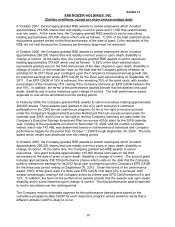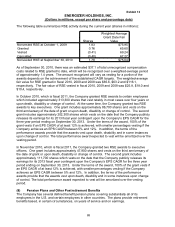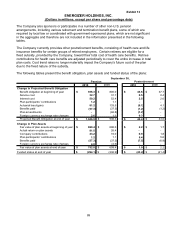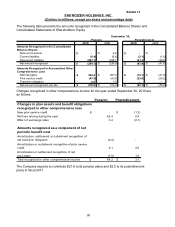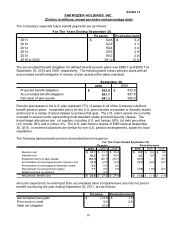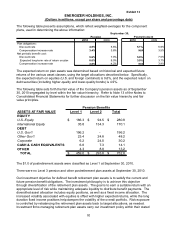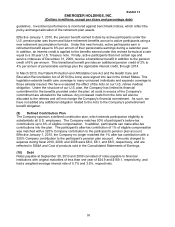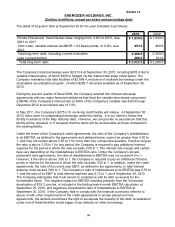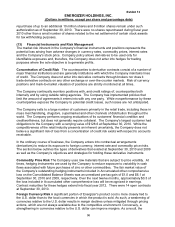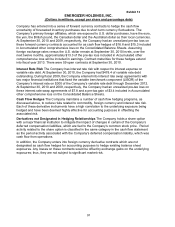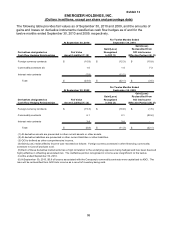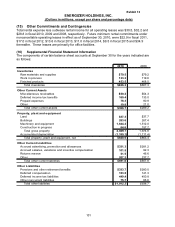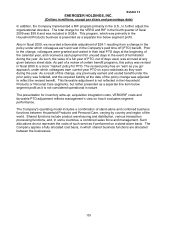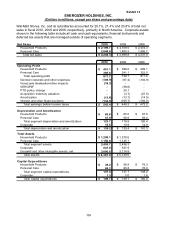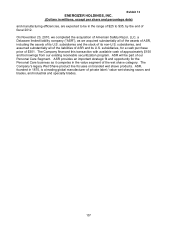Energizer 2010 Annual Report Download - page 107
Download and view the complete annual report
Please find page 107 of the 2010 Energizer annual report below. You can navigate through the pages in the report by either clicking on the pages listed below, or by using the keyword search tool below to find specific information within the annual report.
Exhibit 13
ENERGIZER HOLDINGS, INC.
(Dollars in millions, except per share and percentage data)
97
Company has entered into a series of forward currency contracts to hedge the cash flow
uncertainty of forecasted inventory purchases due to short term currency fluctuations. The
Company’s primary foreign affiliates, which are exposed to U.S. dollar purchases, have the euro,
the yen, the British pound, the Canadian dollar and the Australian dollar as their local currencies.
At September 30, 2010 and 2009, respectively, the Company had an unrealized pre-tax loss on
these forward currency contracts accounted for as cash flow hedges of $16.8 and $15.3 included
in Accumulated other comprehensive loss on the Consolidated Balance Sheets. Assuming
foreign exchange rates versus the U.S. dollar remain at September 30, 2010 levels, over the
next twelve months, approximately $13.3 of the pre-tax loss included in Accumulated other
comprehensive loss will be included in earnings. Contract maturities for these hedges extend
into fiscal year 2013. There were 59 open contracts at September 30, 2010.
Interest Rate Risk The Company has interest rate risk with respect to interest expense on
variable rate debt. At September 30, 2010, the Company had $478.4 of variable rate debt
outstanding. During fiscal 2009, the Company entered into interest rate swap agreements with
two major financial institutions that fixed the variable benchmark component (LIBOR) of the
Company’s interest rate on $300 of the Company’s variable rate debt through December 2012.
At September 30, 2010 and 2009, respectively, the Company had an unrealized pre-tax loss on
these interest rate swap agreements of $7.8 and a pre-tax gain of $3.4 included in Accumulated
other comprehensive loss on the Consolidated Balance Sheets.
Cash Flow Hedges The Company maintains a number of cash flow hedging programs, as
discussed above, to reduce risks related to commodity, foreign currency and interest rate risk.
Each of these derivative instruments have a high correlation to the underlying exposure being
hedged and have been deemed highly effective for accounting purposes in offsetting the
associated risk.
Derivatives not Designated in Hedging Relationships The Company holds a share option
with a major financial institution to mitigate the impact of changes in certain of the Company’s
deferred compensation liabilities, which are tied to the Company’s common stock price. Period
activity related to the share option is classified in the same category in the cash flow statement
as the period activity associated with the Company’s deferred compensation liability, which was
cash flow from operations.
In addition, the Company enters into foreign currency derivative contracts which are not
designated as cash flow hedges for accounting purposes to hedge existing balance sheet
exposures. Any losses on these contracts would be offset by exchange gains on the underlying
exposures; thus, they are not subject to significant market risk.


